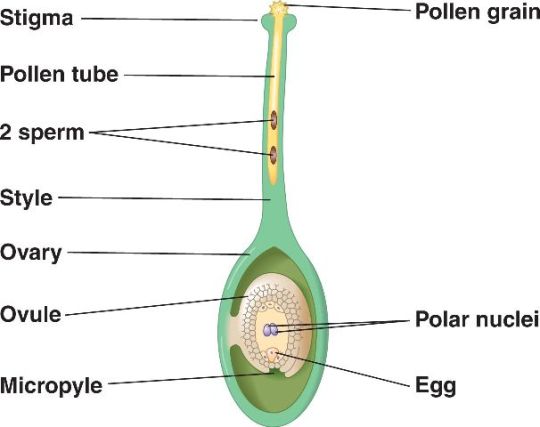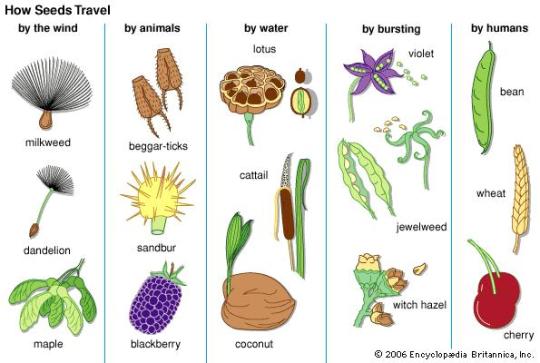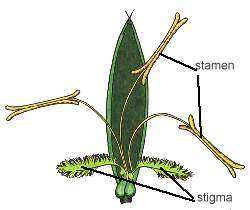Tagged: flower

Sexual Reproduction in Plants (2) – Grade 9 Understanding for IGCSE Biology 3.4
In the previous post, I looked at the flower structure of both insect and wind pollinated flowers and explained the process of pollination. Now we need to ask “What happens next….?”
When a flower has been pollinated, there will be pollen grains that have landed on the stigma. These might be from a different species of plant in which case, nothing will happen. If they are from a different individual of the same species of plant, then triggered by sugary chemicals on the stigma the pollen grain starts to grow a tube called a pollen tube (imaginative people these plant biologists…..) which grows down through the style.
Pollen tube growth through the style is a complex process and the exact mechanism by which the pollen tube “knows” in which direction to grow is not completely understood. But it does know and grows down through the style and enters the ovule through a tiny opening in the ovule called the micropyle.
Now this is where it gets complicated …… but luckily for your exam, you don’t need to learn about the weird way plants undergo fertilisation. But to give you a taste, the male gamete which is a nucleus in the pollen grain divides on the way down the pollen tube to form two sperm nuclei (see diagram above). Each of these nuclei will fertilise a different nucleus in the ovule, hence the name double fertilisation.
But let’s keep it simple. There is a haploid female gamete called an egg cell inside the ovule and one of the haploid sperm nuclei from the pollen grain will fuse with it in the process of fertilisation. This produces a diploid cell called the zygote that will later develop into the embryo plant.
Quick reminder: Haploid is a term that refers to a cell that only has one member of each pair of chromosomes. Gametes are haploid cells and when two gametes fuse they produce a cell with pairs of chromosomes and this cell is described as Diploid.
The egg cell inside the ovule is now fertilised. It has a full set of chromosomes and is now called a zygote. So what happens to the structures in the flower…? After fertilisation the petals, sepals, stamens, stigma and style all dry out and wither. The ovary develops into a structure called the fruit and inside the fruit, each ovule develops into a seed.
Seeds are tough structures that have evolved to allow the embryo plant to undergo a period of dormancy before the seed germinates. The function of fruit is seed dispersal. It is vital for the parent plant that its offspring do not start to grow right next to themselves as they will be in direct competition with the parent for water and minerals from the soil and for sunlight. For animals it is easy for the parent to get rid of their offspring – they simply kick them out of the nest or send them to boarding school to get them out of the house…. Plants need to rely on more ingenious strategies….
In some plants the fruit has evolved to disperse the seed using the wind. Sycamore seeds have a propellor blade to slow down their fall from the tree. Dandelions give each seed a tiny parachute and can be carried for many miles in the wind.
But animals are more commonly used as couriers to get the seeds away from the parent plant. The fruit may be sweet and attractive to eat; the fruit may have hooks or barbs to get stuck to the animals body. Many seeds are dispersed by animals in a wide variety of ways…
It is really important not to get confused between the role of animals as pollinators of flowers and their separate role in seed dispersal. Keep these two processes (pollination and seed dispersal) clearly separated in your notes and in your mind. In the stress of the exam, candidates often get muddled and so write nonsense….. This is something to avoid if possible!
PMG tip: organise your notes on plant reproduction into the following subheadings to keep things separate.
- Flower Structure
- Pollination
- Fertilisation
- Seed Dispersal
- Germination

Sexual Reproduction in Plants (1) Grade 9 Understanding for IGCSE Biology 3.3
Sexual reproduction in plants is a topic that some students find difficult at iGCSE. Perhaps it is the plethora of jargon terms, perhaps there are one or two complex ideas to master, perhaps it is just because some people just aren’t interested in plants (more fool them…) Anyway this post will attempt to cover all the main ideas needed for an A* understanding…. Flower structure The flower is the reproductive organ of the plant. A key difference in reproductive biology between animals and plants is that the majority of plants are hermaphrodite. Hermaphrodite means “an organism able to produce both male and female gametes”.

The male gamete in plants is a nucleus found inside a pollen grain, the female gamete is an egg cell nucleus found inside a structure called an ovule in the ovary of the flower. The male parts of the flower are called stamens. Stamens are made up of the pollen-producting anther supported on a stalk called the filament. The female part of the flower is called the carpel. The carpel is made of a stigma (adapted for receiving pollen), a thin style and a swelling at the base called the ovary. Inside the ovary are one or more smaller structures called ovules that contain the egg cells, ova that are the female gamete. The flower also has petals, often brightly coloured and scented to attract insects and that are protective structures that cover the flower when it is still a bud.
Pollination is the “transfer of pollen from the anther to the stigma“. Please learn this definition! A few plants (such as the garden pea) self-pollinate. This means pollen grains from one flower stick to the stigma of the same flower. If you want to irritate me in class, tell me that this is a type of asexual reproduction because only one parent is involved. I will respond with a strange facial grimace and a low guttural growl…… You have been warned. A plant that self-pollinates is still undergoing sexual reproduction as it is making gametes (by meiosis so every gamete will be genetically different) and then fertilising them in a random process. The offspring of self-pollination will still be genetically different from each other but the total genetic variation will be less than if DNA from two different individuals is used.
The vast majority of plants cross-pollinate. They transfer pollen from the anther of one flower to the stigma of a flower on a different plant. Cross-pollination can be brought about by a variety of mechanisms but the commonest two in the UK are by insects and by the wind.
The diagrams above all show flowers that are pollinated by insects. But look at this flower.
The stamens are large and hang outside the flower. The petals are green and small. The stigma is also hanging outside the flower and is large and feathery. This is a flower of a grass plant and typical of a wind-pollinated species.








